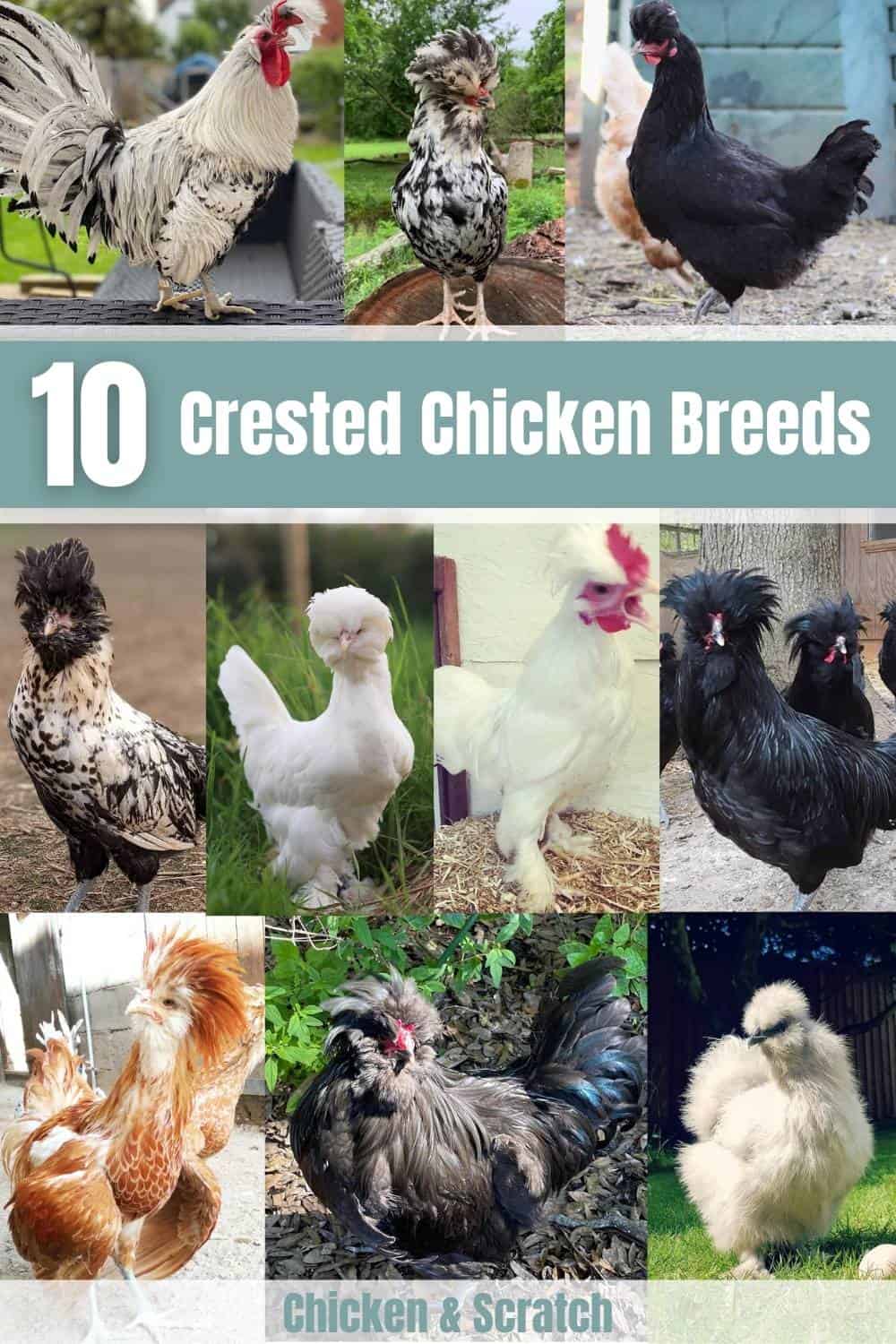How do you decide which chicken with afros or most popularly known as crested chickens when each one of them is stunning? Crested chickens are these attention-grabbing birds with heads adorned with lavish crests of feathers. These eye-catching fowls vary in colors and sizes, plus they’re chicken breeders’ favorite.
Fun Crested Chickens For Your Backyard
Crested chicken breeds originated in countries such as China, Poland, France, Italy, the Netherlands, Russia, and Turkey, and they can now be found in various other countries. Each variety of these chickens also has another purpose. Some are produced as table birds, others for egg production, while some are for pleasure.
The crested breeds are the greatest attention-grabbing and gorgeous fowls with their packed, feathery crest. The youngest chicks are the most lovely and cutest as their crests show up like a little top hat.
More so, the top lists of friendliest pet chickens come from the crested birds. Not only are these fowls unique, ornamental, and rare, their temperament also makes them one of the calm and gentle breeds in the backyard.
The crested breed of chickens is gentle and quiet that doesn’t wander too far from their coops. And breeders should be wary as this breed of chicken needs more protection from predators. Their lengthened plumes make them a primary focus for attack.
More so, breeders should be more aware of possible problems these crested ones encounter every day. Knowledgeable breeders can make modifications so that the fowls’ quality of life improves and guarantees flock harmony. Let’s look at these different breeds of crested birds and their challenges and temperaments that can help our chickens with afros.
1. Appenzeller
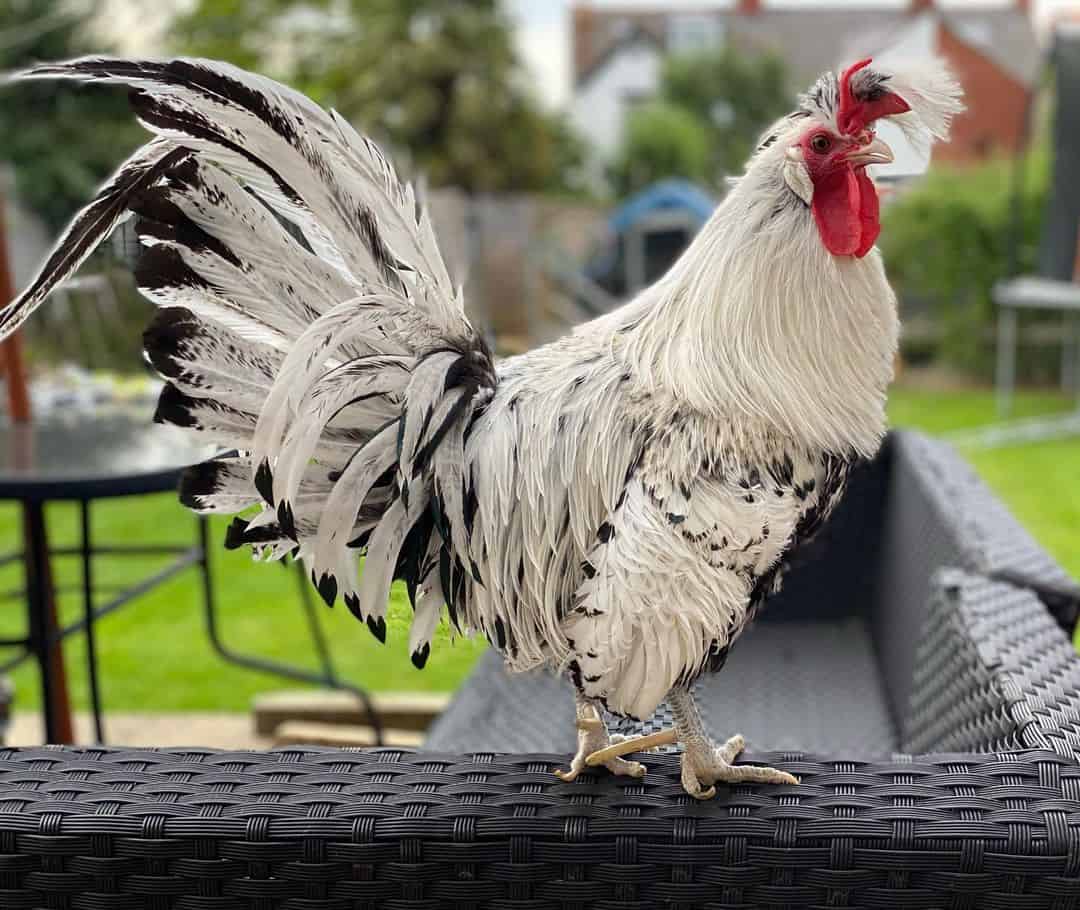
| Feature | Description |
| Purpose | Ornamental |
| Heat Tolerance | Good heat tolerance |
| Cold Tolerance | Excellent cold tolerance |
| Comb Type | Single comb |
| Life Span | 6-8 years |
| Adult Weight | 4-6 pounds |
| Backyard Friendly | 4/5 |
This chicken that comes from Switzerland comes in 2 varieties. The Barthuhner, named for a bearded hen, has a rose comb but lacks a crest. And the Spitzhauben named for a women’s hat has a feather crest and V-comb. The color varieties of Appenzeller are golden spangled, silver spangled, and black.
The Appenzeller Spizhauben’s crest stands out more even when it’s smaller than a Polish chicken. The Appenzeller’s crest looks more fluffed and groomed. It would be surprising for other breeders to know that the Appenzeller Spitzhauben is the national bird for Switzerland.
Though the Appenzeller breed is for ornamental purposes only, the hens lay an adequate number of white eggs. The Appenzeller hens can lay around two to four medium white eggs.
Though small in stature, they can roost in trees. These birds go well growing in mountainous locations, plus they are great walkers because of their origin. These chicken breeds are more or less adaptable to their surroundings.
These fowls are better in a free-range environment than cooped ones because they’re active and good scavengers. This chicken from Switzerland doesn’t like confinement, so it’s most appropriate if they wander in open yards liberally. More so, they are cold-hardy but can tolerate heat well too.
2. Brabanter

| Feature | Description |
| Purpose | Dual-purpose breed |
| Heat Tolerance | Good heat tolerance |
| Cold Tolerance | Excellent cold tolerance |
| Comb Type | V-shaped or butterfly comb |
| Life Span | 6-8 years |
| Adult Weight | 5-7 pounds |
| Backyard Friendly | 4/5 |
This Dutch breed originated between Belgium and the Netherlands. The Brabanter chickens are small-bodied with a V-shaped comb, and their crest is like the Appenzeller. The Brabanter hens lay a moderate number of white eggs. These hens are also winter layers because they are suited better for colder weather.
But compared to other cold hardy chicken breeds, these Dutch strains are less prone to frostbite because of their small comb and wattles. This breed of chicken is intelligent and calm.
Brabanters also have various patterns and colors and come in bantam strain, but that’s amazingly rare. However, this chicken is not yet on the standard list of the American Poultry Association.
These chickens also have some exceptional traits aside from their gorgeous plumage. Barbanters have a trilobed beard and muffs. More so, these chickens have comb with V-shaped, also called the devil’s comb or horn comb. And these fowls crest is forward-facing that develops vertically, so it’s sometimes called a shaving-brush crest.
Like other crested breeds, these birds also have flared and big nostrils. However, unlike the other crested ones as well, Barbanters do not have domed skull knobs. These chickens’ beards and muffs hide their small (sometimes absent) wattles and small white earlobes.
3. Burmese Chicken
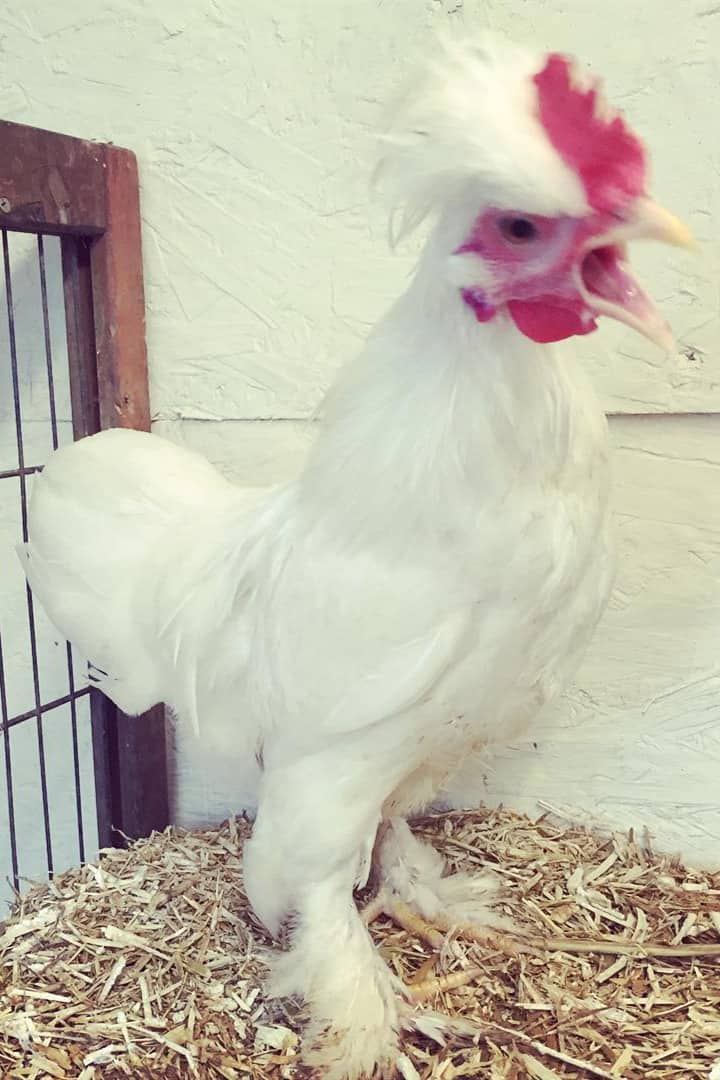
| Feature | Description |
| Purpose | Dual-purpose breed |
| Heat Tolerance | Good heat tolerance |
| Cold Tolerance | Moderate cold tolerance |
| Comb Type | Single comb |
| Chicken Skin Color | Yellow to light pink |
| Life Span | 6-8 years |
| Adult Weight | Roosters: 6-7 pounds; Hens: 4-5 pounds |
| Backyard Friendly | 4/5 |
Burmese is a bantam chicken that has short legs dense with feathers. From its name, this attractive chicken breed originated from Myanmar. During 1880, a British army officer posted in Burma sent three Burmese Bantams to a fellow officer in Scotland.
The cockerel survived while the hens died. The first was bred with a Sultan Bantams archetype to bring back its characteristics.
According to the breed’s history, although the population of these chickens declined, Andrew Sheppy managed to acquire some in 1970. The new set of chickens were not so fertile, so Sheppy bred them with the White Booted Bantams to revive the process to Entwisle’s.
That’s why Burmese Bantams look a bit the same as Booted Bantams but with a lower and smaller tail carriage. But each Burmese Bantam has a beautiful crest of feathers sticking out upwards from their heads. Even as a bantam chicken, this breed is incredibly fertile and develops robustly.
Burmese hens are excellent brooders and mothers who lay brown eggs. Because Burmese chickens are rare, many hoped their eggs would go to the incubator rather than the dining table.
These Myanmar chickens have a feathered crested head with a single comb. Both hens and cocks are pure white. Because of their white color and feathered feet, these chickens also require proper mud-free coops to keep them clean.
4. Crevecoeur
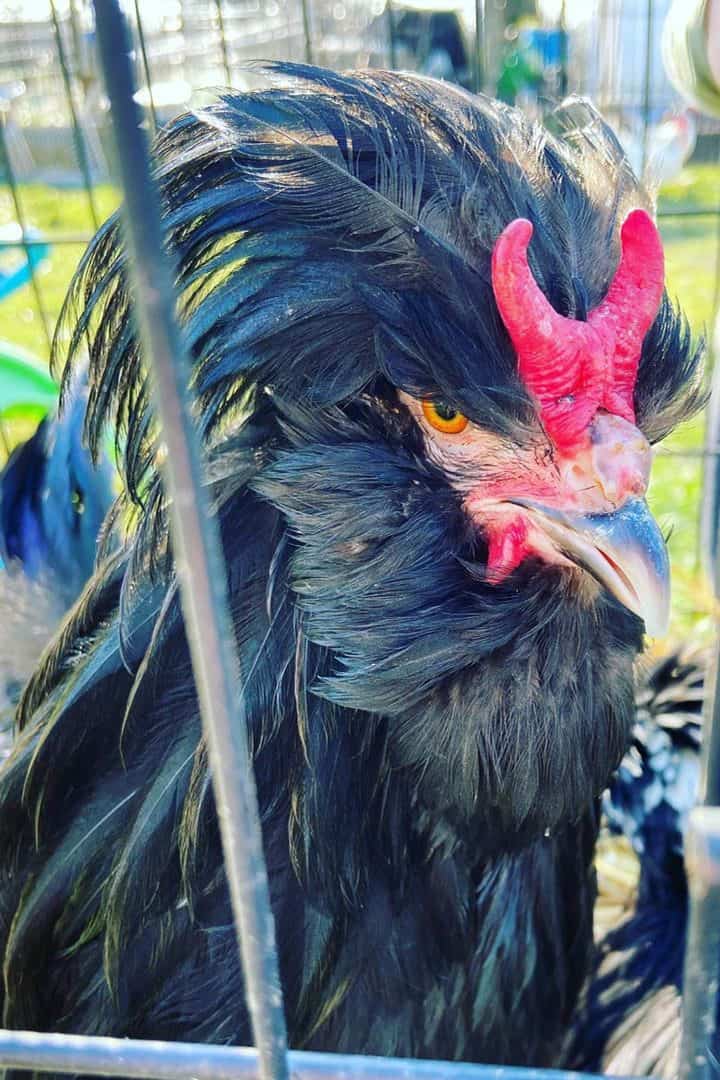
| Feature | Description |
| Purpose | Dual-purpose breed |
| Heat Tolerance | Good heat tolerance |
| Cold Tolerance | Excellent cold tolerance |
| Comb Type | V-shaped comb |
| Life Span | 6-8 years |
| Adult Weight | Roosters: 7-8 pounds; Hens: 6-7 pounds |
| Backyard Friendly | Rating: 5/5 |
This French chicken breed got its name in a small village of Crèvecœur en Auge in Normandy, which translates to “broken heart.” The character develops from the fact that the area in this region is less fertile, breaking the hearts of the peasants.
Crevecoeur is famous in its home country in France but is entirely unknown yet in other countries. The Livestock Conservancy stated that this breed is among the rarest chicken strains, so more people need to breed these chickens in the US. The global population of Crevecoeur is under 1000 birds, while the present US breeding fowls is under 500.
Crevecoeur chickens have calm, quiet, and easy handle personalities. While the Crevecoeur can survive fine in grasslands foraging on lovely days, they are better in confined spots safe from harsh weather conditions and predators.
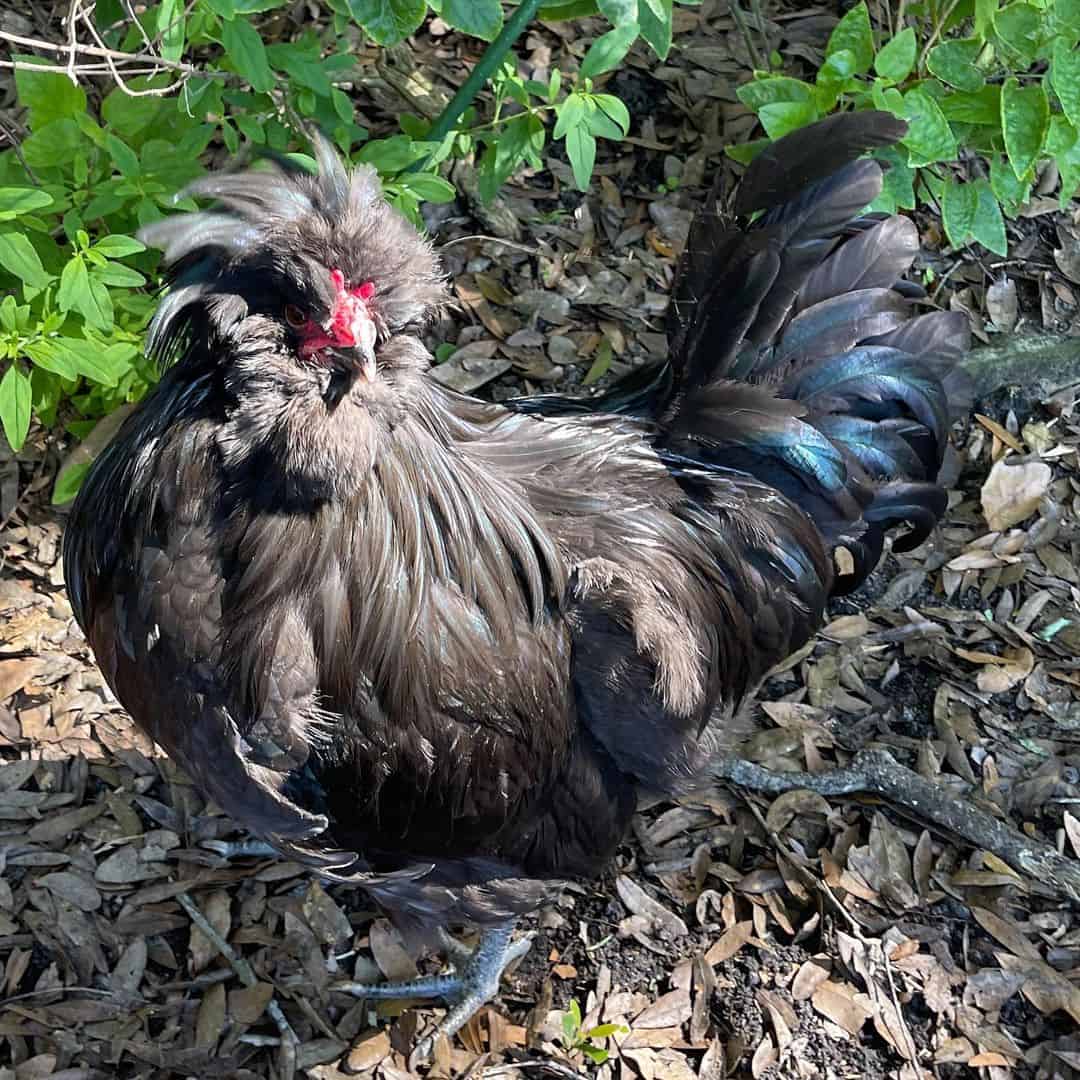
This old breed from France has a unique V-shaped comb and solid black. Crevecoeur’s have the same size as the Houdans except that the first only has four toes and is black. This breed of chicken has white skin, small and delicate bones.
They are table birds and only lay about 120 large white eggs per year. The breed is known for its meat, which is very white in the breast area and darker on the leg, almost akin to the color of duck meat. like an almost duck-like color. These table birds also fatten eagerly.
5. Houdan

| Feature | Description |
| Purpose | Ornamental |
| Heat Tolerance | Moderate heat tolerance |
| Cold Tolerance | Excellent cold tolerance |
| Comb Type | V-shaped or butterfly comb |
| Life Span | 6-8 years |
| Adult Weight | Roosters: 7-9 pounds; Hens: 6-7 pounds |
| Backyard Friendly | 4/5 |
Another chicken breed from France is Houdan. These French birds originated from their five-toed chicken ancestors that were quite popular in Belgium and France. Houdans are the primary table bird breed in these countries in the nineteenth century. These multi-purpose birds are excellent as backyard chickens or show birds.
This dual-purpose chicken breed is incredibly famous and adored in history for its meat quality and egg laying. These French chickens can rival Leghorns in egg-laying.
The hens are broody every so often, but it’s most excellent to have the lighter strains be egg sitters as a substitute or an incubator because they tend to be heavy. But Houdan hens are good layers, even on winter periods.
Houdan chickens are reasonably hardy and somewhat large as they are fast growers. This fowl breed has both crests and beards with mottled white plumage but black. These chickens also come in white and lavender shades.
One of their unique features is their comb that shapes like a butterfly. Because of the Houdan’s huge crest and beard, breeders should provide a special drinker for them. These birds only need a small amount of water in a bowl.
It’s also a better alternative for Houdans to stay in a confined area. This calmer breed is an easy target for meals with a local predator. Because of their temperament and nature, small backyard breeders or farmers prefer Houdans because they’re very safe for kids to play with and pet.
6. Kosovo Longcrower

| Feature | Description |
| Purpose | Ornamental
Exhibition |
| Heat Tolerance | Good heat tolerance |
| Cold Tolerance | Moderate cold tolerance |
| Comb Type | V-shaped |
| Life Span | 6-8 years |
| Adult Weight | Roosters: 6-7 pounds; Hens: 4-5 pounds |
| Backyard Friendly | 3/5 (Suitable with proper care) |
This chicken got its name from where it originated, in Drenica in Kosovo. This long crowing chicken is also called the Drenica. This fowl is said to be the black color strain of the Sanjak Longcrower.
Drenica has a crest of black feathers hiding a comb that’s V-shaped. This Kosovo chicken is primarily black with minimal red or gold specks on the feathers. As these chickens age, their black feathers may fade to white in some areas.
There might also be two proportioned short horns on the nose of the Drenica chickens. These chickens have yellowish-green legs and red earlobes mostly raised by hobbyists who eagerly want to breed rare fowl strains.
Younger Kosovo Longcrower can start laying 160 eggs in a year when the hens are eight months old but drop the egg production when they aged. The egg production reduces to 50 to 70 eggs in a year as these hens become older. More so, the Drenica hens are not excellent egg-sitters.
This fowl is bred by enthusiasts for exhibitions, especially in a crowing contest. The Drenica roosters’ crow can last up to 20 to 40 seconds, but extraordinary cocks can last for 60 seconds. The Kosovo Longcrower roosters begin to crow on their sixth to the seventh month. But, it’s multi-purpose as others raise this breed as a table bird as well.
7. Polish Chicken

| Feature | Details |
| Purpose | Ornamental |
| Heat Tolerance | Yes |
| Cold Tolerance | Yes |
| Comb Type | V-shaped Comb |
| Life Span | 8-9 years |
| Adult Weight | Hen: 3-4 lbs, Rooster: 4-5 lbs |
| Backyard Friendly | 4/5 |
Breeders can quickly recognize Polish chickens because of their crest of feathers that nearly hides their whole head. Polish is the most famous crested breed of chicken and the best one for availability.
The development of this chicken breed was for egg production. Although the origin is unclear, the Netherlands standardized the breed. At present, Polish is more of an ornamental breed. Still, the white-crested black Polish tend to lay more eggs than the other varieties.
The Polish chicken feet don’t have any feathers at the most. Then rooster has a comb with V-shape and a cluttered and wild poof of feathering, while the hens have an orderly and clean crest.
Because their crest of feathers can give them difficulty with their vision thus they are at risk from predators. But, because of their shy nature, plus these chickens can’t see well, they’re easy to catch even for children and fun to be children’s pets. Yet, this chicken breed suits well to confinement because it’s also docile.
The Polish colors are white crested black, golden laced, black mottled to buff laced, and white-crested blue. The Polish hens are unreliable in the egg production department. Each can only lay approximately two to three eggs weekly. They’re best for ornamental or exhibition purposes because of their different colors, unique appearance, and temperament.
8. Polverara
| Feature | Description |
| Purpose | Dual-purpose breed |
| Heat Tolerance | Good heat tolerance |
| Cold Tolerance | Moderate cold tolerance |
| Comb Type | Single comb |
| Life Span | 6-8 years |
| Adult Weight | Roosters: 5-6 pounds; Hens: 4-5 pounds |
| Backyard Friendly | Rating: 4/5 (Suitable for backyard) |
The name comes from its origin in the Polverara in the province of Padova in Italy. Sciatica or Sciata, as it’s also called, developed chiefly for ornamental purposes like the Brabanter. Polara is a historic strain of the crested fowl breed.
Although these Italian chickens have a fluffy crest that stands on their head, it doesn’t cover their eyes because it’s not too scruffy as well.
Polverara fowls come in black and white colors with white earlobes, small wattles hidden under the beard, and a comb that’s V-shaped. The black Polverara is intense black with a stunning luster and solid dark-green sheen.
These chickens from Italy are pleasing to the eye; that’s why they do well in shows, primarily because of their distinct willow-green legs. Polverara won a spot as a magnificent show bird because of their splendid look. But there are some variants of this fowl with several blends of colors because of crossbreeding but are not standardized.
The roosters weigh approximately 5 pounds while the hens around 4.5 pounds. Even when the hens are not good sitters, they can lay around 150 eggs in a year each.
So if you want a multi-purpose chicken breed, Polverara is perfect for you as it can also serve as a table bird. Its meat is darker than the other chicken breed, but it’s full of flavor and delicate.
9. Silkie
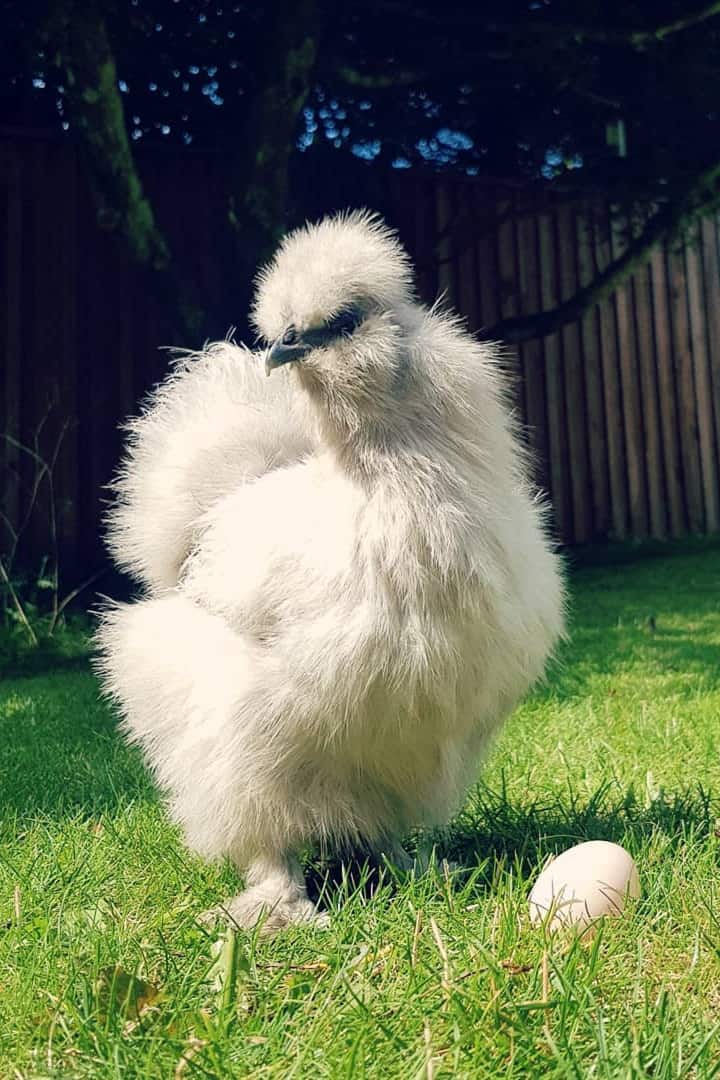
| Feature | Details |
| Purpose | Ornamental |
| Heat Tolerance | No |
| Cold Tolerance | Yes |
| Comb Type | Walnut-shaped Comb |
| Life Span | 5-8 years |
| Adult Weight | Hen: 32-36 oz, Rooster: 36-40 oz |
| Backyard Friendly | 3/5 |
This small but standard breed comes from China. Silkies come in various colors such as black, white, red, blue, and several penciled silver partridge to gray.
The Silkie hens may not be outstanding in the egg production department, but they are favored to be excellent brooders. These hens would be happy to sit on other hens’ eggs. That’s why breeders don’t have any problems breeding Silkies with other breeds that are not doing well as egg-sitters.
Silkies are also very friendly and tame with kids; that’s why they are also the most popular breed you can find in zoos. These cute chickens are easy to handle and fun to have around but amazingly hardy as well.
Like other crested fowls, they also have difficulty with their vision. It’s best recommended for Silkie keepers to pluck and trim feathers around the face or tie their crest. Some varieties of this breed have beards, and others have none.
Like most feathered-feet chickens, silkie also needs a proper and clean coop. Since these short chickens don’t fly, it’s stress-free to put them in a fenced area. Silkies can walk around easily around their brooding area and can take care of themselves well. More so, because they have a lot of poofs, they require no special waterer.
10. Sultan Chicken
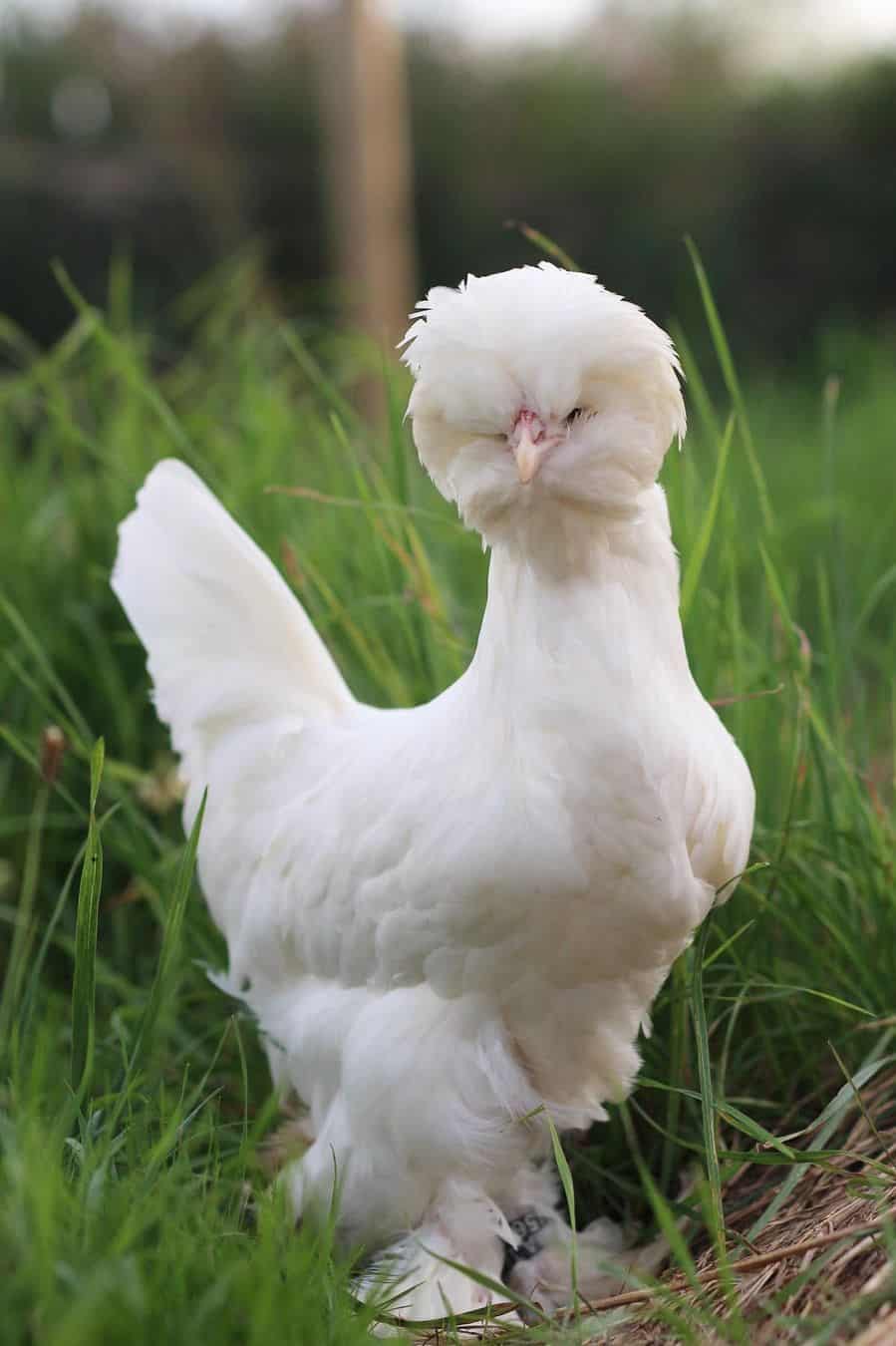
| Feature | Description |
| Purpose | Ornamental, exhibition |
| Heat Tolerance | Moderate heat tolerance |
| Cold Tolerance | Good cold tolerance |
| Comb Type | V-shaped or walnut comb |
| Life Span | 6-8 years |
| Adult Weight | Roosters: 4-5 pounds; Hens: 3-4 pounds |
| Backyard Friendly | Rating: 4/5 (Suitable for backyard) |
If you want to raise a unique and rare bird, this native to Turkey chicken breed is perfect. Sultan is also known as “Serai Taook,” which means the “Fowl of the Sultan’s Palace.”
Sultan chicken breed’s unique physical characteristics include a V-shaped comb, beard, bulging crest, huge nostrils, muffs, low-carried wings, feathered feet, vulture hocks, and five toes on each foot. These Turkish chickens have slate blue legs and pure white feathers. But there are other Sultan varieties as well, such as black and blue.
Sultans are happy chickens in general and adapt well in confined environment also because of their happy nature. The chickens are calm and friendly in temperament.
Since this rare breed from Turkey needs the best care from its breeder, a confined area is also the best for brooding the hens. Make sure the enclosed area has dry and clean bedding to keep their feathered feet dirt-free. These rare birds should be mud-free to keep their feet full of feathers clean all the time.
The hens lay white eggs from March to September. More so, Sultans can also provide excellent meat quality. That’s why dual-purpose chickens, plus their personality, make them a great breed to raise in the backyard.
Sultan chickens are small fowls, but they are standard chicken and not Bantam. The roosters can weigh approximately around six pounds and have tons of feathers.
Final Thoughts
Crested chickens are popular to breeders worldwide for poultry shows or domestic breeding. Their calm and docile nature as well make them good backyard pets for the kids. Are you convinced that one of the crested fowls is the perfect breed for you? Please share your thoughts with us and why.


Joseph Hudson has been raising chickens for over 15 years. In 2018, he completed the Agriculture & Natural Resources program at Mt. San Antonio College. He currently raises over 1400 chickens on his 7.5-hectare farm. He keeps sharing his experience on raising healthy and happy chickens on Chicken Scratch The Foundry.
